Fish and Chips (British Pub Style)
This post may contain affiliate links. See my disclosure policy.
No need to go down to your local pub or chippy or search for a restaurant that makes the best beer-battered fish and chips. This British pub-style, beer-battered Fish and Chips recipe produces that perfectly crispy and flavorful result you’re craving! Serve your homemade fish and chips with our authentic British Mushy Peas followed by a traditional British dessert like Sticky Toffee Pudding or Treacle Tart!
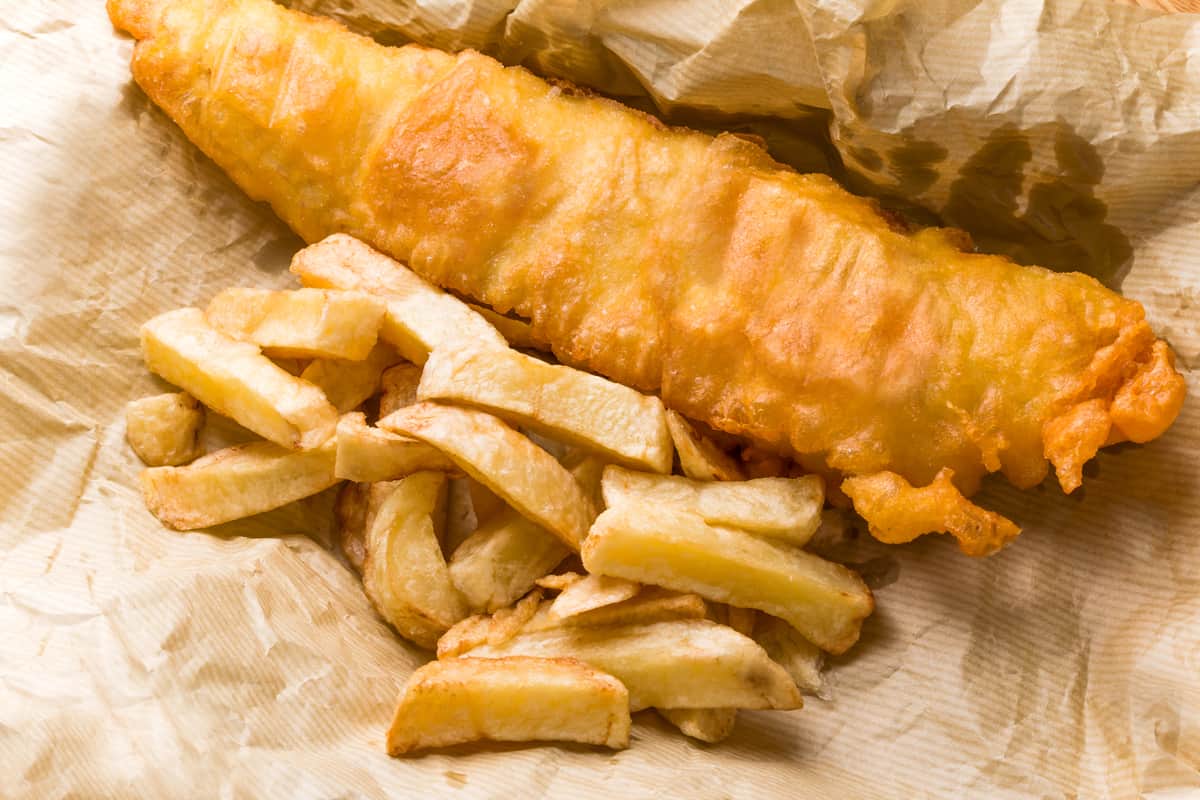
This homemade British fish and chips recipe has been a long time coming. Though I lived in England for several years it wasn’t until our two most recent trips to the UK that I was able to finally perfect the batter and technique. And so the time has come to share with you Great Britain’s most iconic dish: Fish and Chips!
Where Did Fish and Chips Originate?
What we know as fish and chips today originated in England but its earliest origins can be traced back to Sephardic Jewish immigrants from Spain and Portugal where a popular dish known as pescado frito had been enjoyed at least a couple of centuries earlier and was made using a technique of battering and and frying fish in oil. And as for the chips, the credit goes to Belgium.
One of the earliest references to fish and chips in England comes from none other than my favorite author, Charles Dickens, who in 1838 noted the “fried fish warehouses” in Oliver Twist. The famous Victorian chef, Alexis Soyer, also noted in his 1845 cookbook a recipe for “Fried Fish, Jewish Fashion,” a nod to its Sephardic Jewish origins. The first reference to the term “chips” for fries also came from Charles Dickens in A Tale of Two Cities, where he referred to them as “husky chips of potatoes, fried with some reluctant drops of oil.” The first known fish & chips shop was opened by Joseph Malin, a Jewish immigrant, in London in the 1860’s.
Originally a dish of the working classes, fish and chips have remained a cultural icon in the UK for going on two centuries. An article in the Express a few years ago noted some interesting WWII history about the UK’s favorite dish: “During the Second World War Winston Churchill recognised the crucial role of fish and chips, referring to them as ‘good companions’. Fish and chips were two of the few foods not subject to rationing because the government feared the dish was so embedded in the nation’s culture that any limit would damage morale. British soldiers identified one another during the D-Day landings by calling the word fish. The response was chips, signifying an ally.”
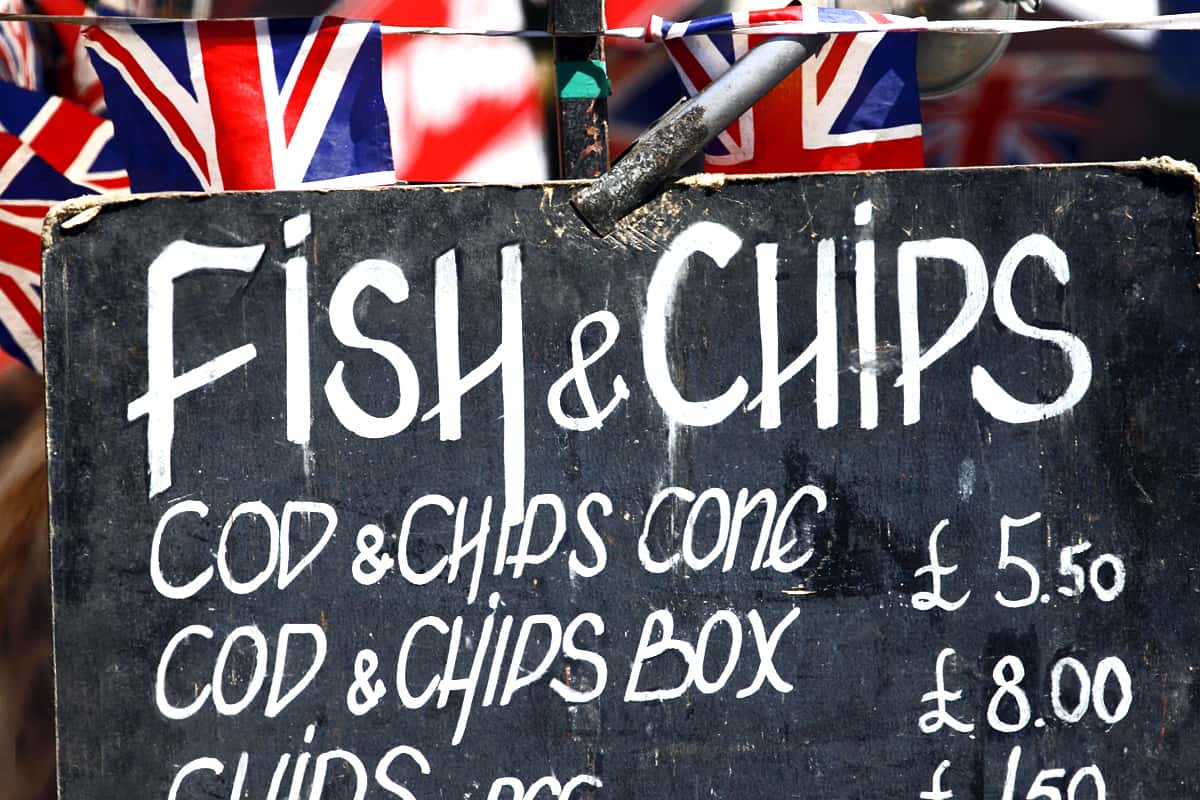
How to Make the Perfect Fish Batter
This is a divisive question that has probably led to more than a few fist fights. Opinions run strong in this arena and everyone has their own. Some say the coating should be thin and light and shatter into crispy shards when you bite into it (that’s what you get with a tempura-style batter but remember friends, tempura is Japanese, not British). Others argue the coating should be thick and puffy and the crispiness should be followed by a touch of chewiness. Some insist the batter should be dry while others are emphatic that if it isn’t seeping a bit of oil then it isn’t worth eating. In the end it all comes down to personal preference.
I lived in England for seven years and we go back every year to visit. From the northern to the southern tip of England, we’ve hit more fish and chip shops than I can number. Based on my experience of eating at dozens upon dozens of chippies throughout the country, the best fried fish is perfectly crispy and isn’t overly greasy or dripping with oil. It’s the kind of batter where you both hear and feel it crunch when you bite into it followed by your teeth sinking into the tender white flesh of the fish.
There are a few key elements for achieving the best fish batter:
- To achieve the best texture the beer must be very cold and you must use the batter immediately. If you let it rest for a while like some recipes recommend the fried coating will be heavier and denser.
- For the same reason, if possible chill the flour before using it to coat the fish.
- Absolute key is the correct temperature of the oil. I address this in my Schnitzel post where the same rule applies, only in the case of fish it cooks more quickly so you can raise the temp up a bit. The key is making sure the oil is hot but not too hot. If the oil is too hot the crust will burn before fish is done, and if the oil isn’t hot enough you’ll end up with a soggy, greasy coating. When the oil temperature is just right (this is beginning to sound like the story of the Goldilocks and the Three Bears) you’ll achieve that perfectly crispy coating with a tender and moist interior. The right temperature for fish batter should be between 350ºF and 375ºF. I usually aim for somewhere in the middle. If you’re not using a deep fryer with its own temperature gauge, test it with a thermometer.
Fish Batter Ingredients
To make the best fish batter you’ll need flour, beer, baking power and salt. The beer and baking powder are key ingredients to achieving a light and airy batter. Plus the beer gives the fish that indisputably irreplaceable traditional British flavor.
Some recipes call for adding an egg but unless you prefer a chewier, “cakier” texture, avoid it. (If you do prefer that, use this recipe and beat an egg into the batter). But we’re omitting the egg because what we’re aiming for is crispy perfection. For the BEST tasting fish and chips, when it’s time to fry use beef tallow! Check out my tutorial on How to Make Beef Tallow. It’s super easy!
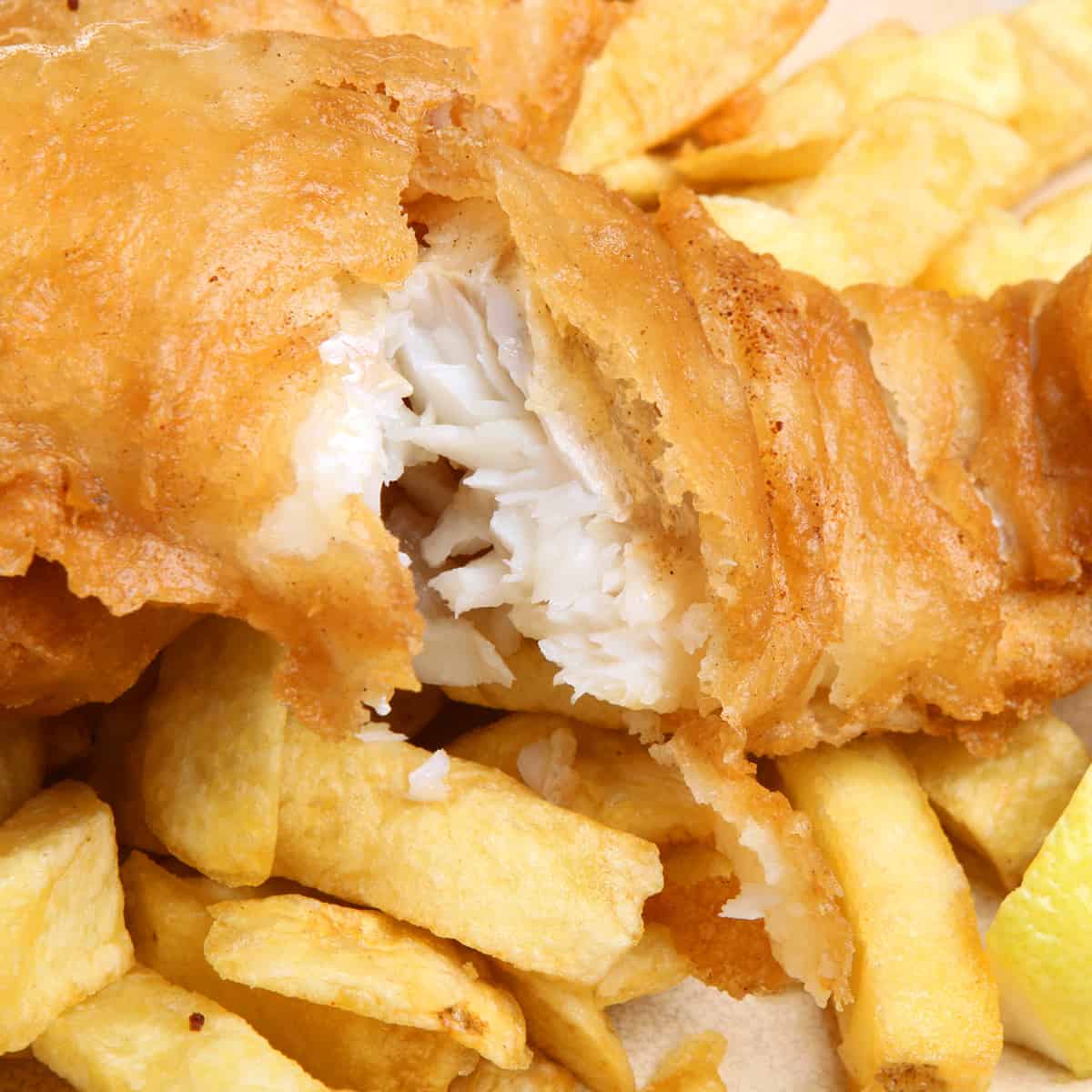
Fish and Chips Recipe
How to Make Chips
Heat the oven to 200 F. Heat the oil in a deep fryer or a large heavy pan or Dutch oven until the temperature reaches over high heat until it reaches 325 degrees F. For the BEST tasting fish and chips, use beef tallow! Check out my tutorial on How to Make Beef Tallow – it’s super easy!
Thoroughly drain the sliced potatoes and blot them with paper towels to remove excess water. Once the oil is 325 F carefully fry the potatoes in small batches to avoid overcrowding and fry for 2-3 minutes until pale and softened. Use a slotted spoon to remove them from the oil and let them cool to room temperature.
Increase the temperature to 375 degrees F. Carefully add the fries again, frying in small batches, until they are golden, another 2-3 minutes. Remove with a slotted spoon, place them on a baking sheet or roasting rack, sprinkle with salt while they’re still very hot, and place them in the warmed oven while you’re frying the fish.
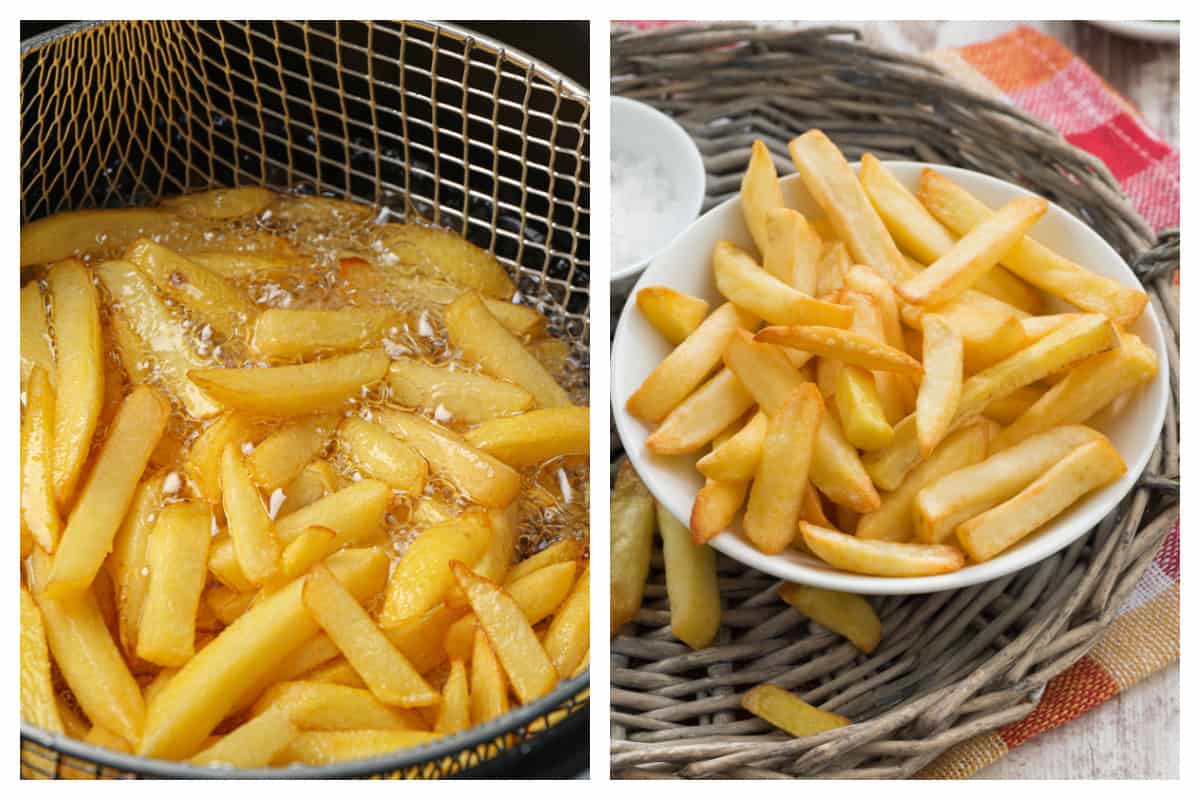
How to Make Fried Fish
Combine the flour, baking powder and salt in a large flat bowl. Pour in the cold beer and whisk until smooth. In another large flat bowl add some extra flour for dredging.
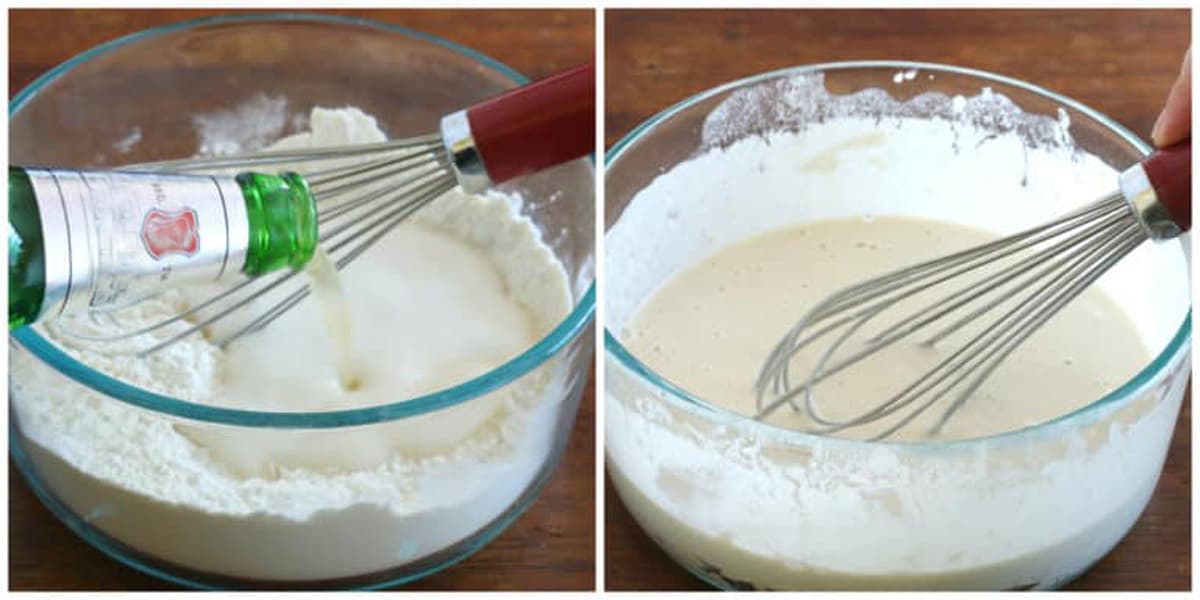
Blot the fish with paper towels to remove excess moisture. Thoroughly dredge all sides of the fish in the flour and shake off the excess.
Dip the fish into the beer batter to thoroughly coat all sides, allowing some of the excess batter to drip off (but not too much!). If you prefer an extra thick coating you can repeat the process of dredging the fish in flour followed by the batter.
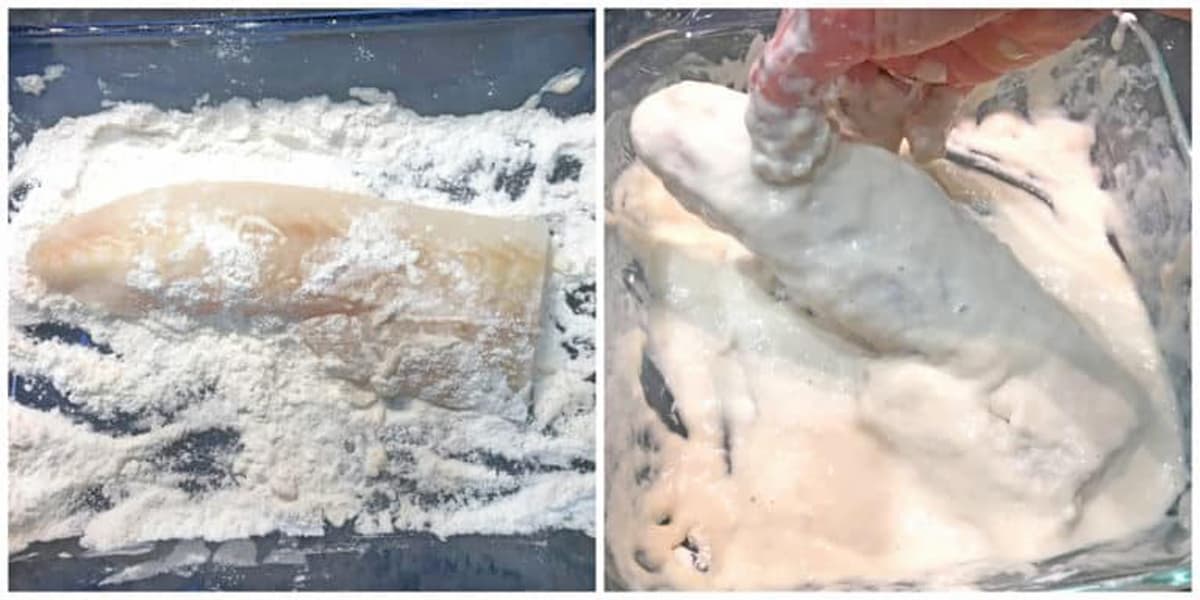
For Frying: You can either use a deep fryer or you can use a medium-sized skillet and fill it with oil to a depth of at least an inch.
Heat the oil to between 350 F and 375 F, using a thermometer. Carefully lower the fish into the oil, waiting a few seconds before releasing it to prevent it from sticking to the bottom. Fry the fish in the deep fryer for 5-8 minutes or until nicely golden. If using a frying pan fry the fish for about 2-3 minutes on each side or until nicely golden.
Remove the fish with a slotted spoon, letting the oil drop off, then place the fried fish on paper towels for a few seconds and serve immediately. If you wait too long to serve it the batter will lose its crispiness.
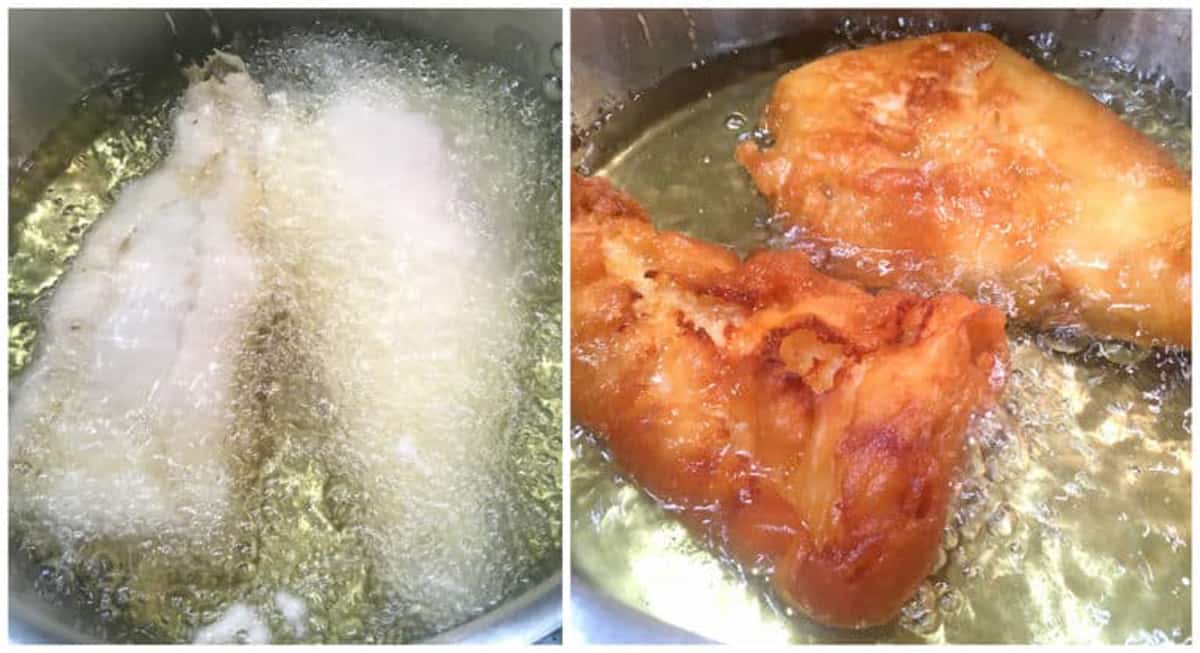
Serve the fried fish with the chips. It’s traditional to shake some British malt vinegar over everything.
The traditional side is mushy peas. Check out our recipe for authentic British Mushy Peas!
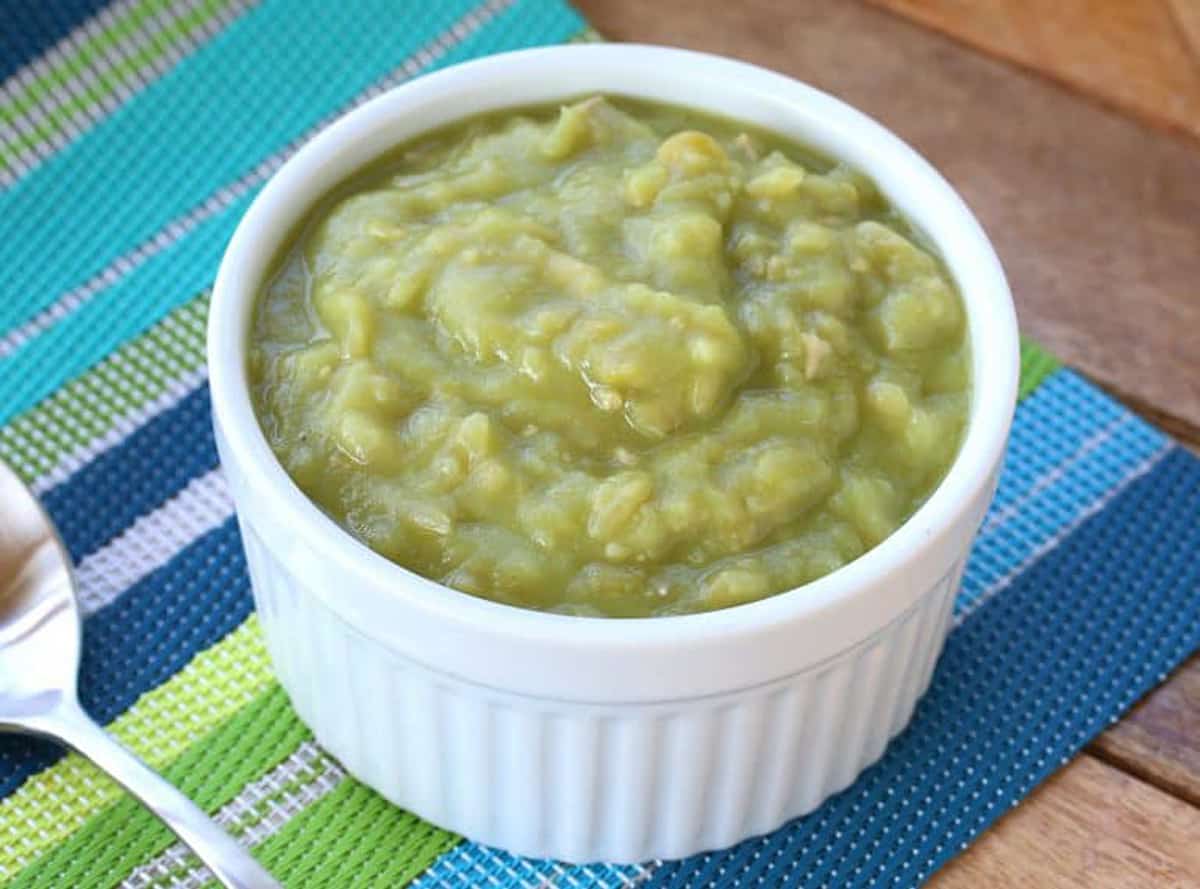
Serve hot while the fish is nice and crispy. Enjoy!
Prefer some tartar sauce with your fish? While it’s not traditional in the UK, feel free to serve it with our best homemade Tartar Sauce.
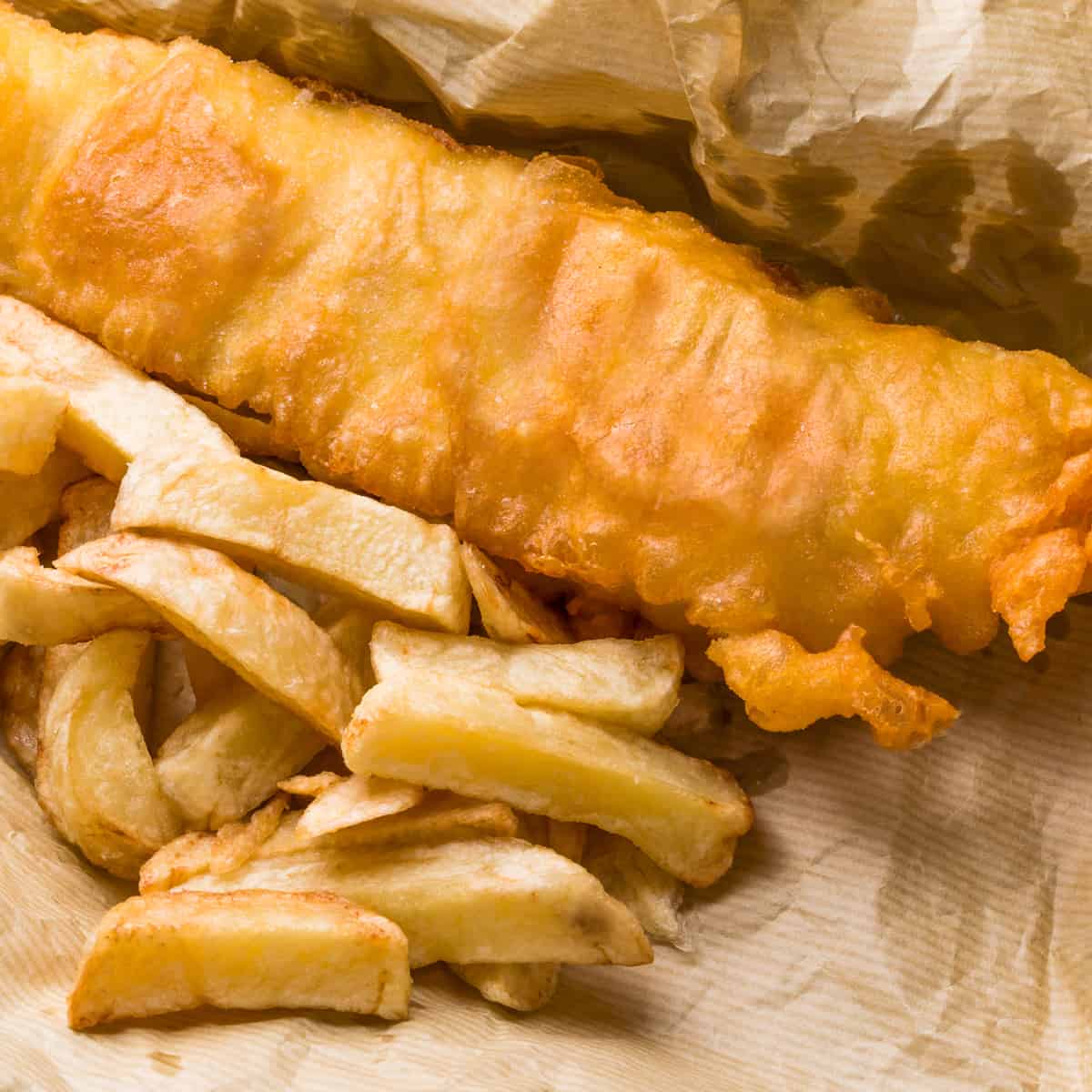
Other Uses for Fish Batter
You’ll likely have some fish batter left over or you can make a separate dedicated batch for other fried foods. Besides using the batter for your fish and chips you can also use it to make:
- Fish Tacos: cut your fish into bite-sized pieces, dip them in batter, and fry until cooked through, using the same guidelines. Serve on warm tortillas with your favorite taco toppings.
- Fried Shrimp, Clams, Scallops and Calamari: simply dip and fry.
- Vegetable Fritters: cut up your favorite vegetables, like broccoli, zucchini, or cauliflower and dip them in batter before frying.
- Onion Rings: thinly slice the onions, dip them in the batter, and fry. This beer batter makes the best fried onion rings!
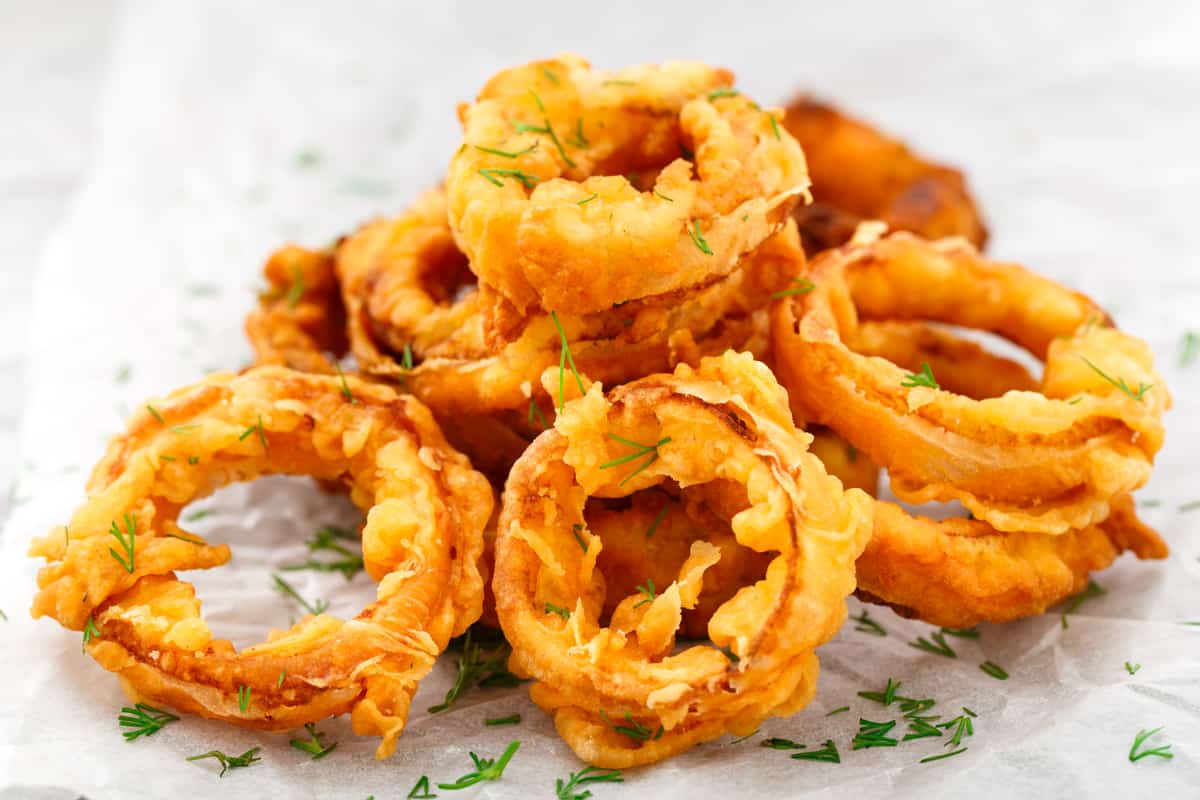
Where to Find the Best Fish and Chips?
Tell us in the comments below where you’ve had the best fish and chips! There are many great fish and chip shops and I’d be hard-pressed to narrow it down. My husband Todd used to live in Liverpool and his vote goes to a chippy there that sadly closed down a couple of years ago and he’s been on the lookout for a new favorite. (If anyone can recommend a great one in Liverpool specifically he would be elated.) But aside from once having had the best fish and chips, Liverpool is a great city with a rich history. One of our favorite things to do is to walk along the Albert Docks at dusk. And Todd and I are lifelong Beatles fans so there’s that connection too. (On a side note, growing up in Liverpool Paul McCartney was a huge fish and chips fan. Until he became a vegetarian. But that’s another story.) When I lived in England our family had a tradition of visiting Liverpool and while there would eat at the Harry Ramsden restaurant. Ramsden’s restaurant actually earned the Guinness Book of Records title for having served 10,000 portions of fish & chips in a single day!
WHERE HAVE YOU HAD THE BEST FISH AND CHIPS? TELL US IN THE COMMENTS BELOW!
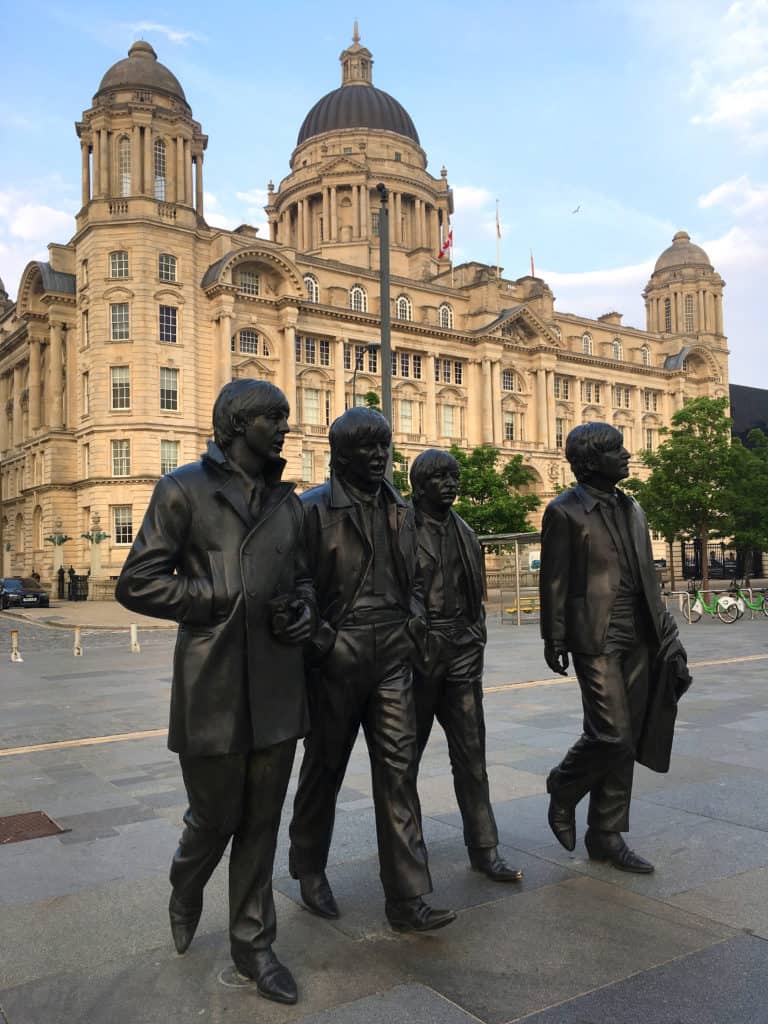
For more authentic British recipes try my:
- Yorkshire Pudding
- Cornish Pasties
- Bangers and Mash
- Scotch Eggs
- Crumpets
- Coronation Chicken
- Sticky Toffee Pudding
- Lardy Cake
- Beef and Guinness Stew
- Spotted Dick
- Toad in the Hole
- Chicken Tikka Masala
- Pickled Onions
- Scottish Shortbread
- Treacle Tart
Save This Recipe
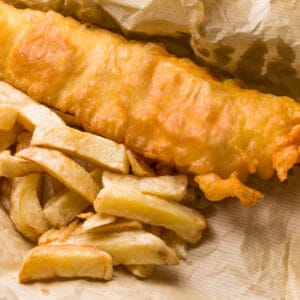
Fish and Chips (British Pub Style)
Ingredients
- 1 cup all-purpose flour
- 1 teaspoon baking powder
- 1 teaspoon salt
- 1 1/4 cups light beer , VERY COLD **See NOTE
- extra flour for dredging , chilled
- 1 1/2 pounds fresh cod, haddock or halibut , (or other firm-fleshed white fish), cut into 4 pieces and patted dry (important for enabling the batter to adhere)
- oil for frying
- use beef tallow instead of oil for the best traditional flavor (click link for recipe – it's super easy to make!)
- For the Chips:
- 4 large Russet potatoes or other high starch/low moisture potato , peeled, sliced thickly and put in a large bowl of cold water until ready to fry
- salt for sprinkling
- oil for frying
- quality British Malt Vinegar , for serving
Instructions
- *See blog post for details on pro tips. To Make the Chips: Heat the oven to 200 F. Heat the oil in a deep fryer or a large heavy pan or Dutch oven until the temperature reaches over high heat until it reaches 325 degrees F (I use this instant read thermometer). Thoroughly drain the sliced potatoes and blot them with paper towels to remove excess water. Once the oil is 325 F carefully fry the potatoes in small batches to avoid overcrowding and fry for 2-3 minutes until pale and softened. Use a slotted spoon to remove them from the oil and let them cool to room temperature. Increase the temperature to 375 degrees F. Carefully add the fries again, frying in small batches, until they are golden, another 2-3 minutes. Remove with a slotted spoon, place them on a baking sheet or roasting rack, sprinkle with salt while they're still very hot, and place them in the warmed oven while you're frying the fish.
- To Make the Fried Fish: Combine the flour, baking powder and salt in a large flat bowl. Pour in the cold beer and whisk until smooth (use the batter immediately, do not let it rest for a while). In another large flat bowl add some extra flour for dredging.Blot the fish with paper towels to remove excess moisture. Thoroughly dredge all sides of the fish in the flour and shake off the excess.Dip the fish into the beer batter to thoroughly coat all sides, allowing some of the excess batter to drip off (but not too much!) If you prefer an extra thick coating you can repeat the process of dredging the fish in flour followed by the batter.
- To Fry the Fish: You can either use a deep fryer or you can use a medium-sized skillet and fill it with oil to a depth of at least an inch. Heat the oil to between 350 F and 375 F, using a candy thermometer. Carefully lower the fish into the oil, waiting a few seconds before releasing it to prevent it from sticking to the bottom. Fry the fish in the deep fryer for 5-8 minutes or until nicely golden. If using a frying pan fry the fish for about 2 minutes on each side or until nicely golden. Remove the fish with a slotted spoon, letting the oil drop off, then place the fried fish on paper towels for a few seconds and serve immediately. (If you wait too long to serve the batter will lose its crispiness.)Serve with the chips, a sprinkling of quality British malt vinegar and if desired a serving of authentic British Mushy Peas. Though not traditional in the UK, you can also eat the fish with our homemade Tartar Sauce.
Video
Notes
Nutrition
Originally published on The Daring Gourmet August 3, 2019



















Fantastic recipe! Came out crispy and just the right thickness.
Awesome, thank you so much Leyza!!
I love your blogging style. Full of information, no wasted time – but with just one or two nice stories or funny jokes, very tastefully done. So knowledgeable, so respectful of the different cultures and the histories of the dishes. I’m convinced you are a genius!
Thank you for the ultimate recipe, I’m on a quest to make the perfect fish and chips and can’t wait to try it. Was loved by the D-Day story, amazing.
I really appreciate your kind words, Bronze, thank you so much <3 I'm definitely no genius, lol, but I do try to learn as much as I can and to be respectful of other cultures :) Happy cooking and I hope you enjoy the fish and chips!
This recipe is perfection! And I can say that with confidence because I’ve tried many fish and chips recipes. My search for the best beer battered fish ends right here. Kimberly, keep the recipes coming!
Ah thank you so much, Sue, I appreciate that! <3
This was so incredibly delish! I agree with all of the positive reviews here, this really makes the BEST fish and chips!
Thank you so much, Deborah, I appreciate that!
It’s a keeper. Crispy with a substantial crust is the way I like my fish with chips. Followed the recipe exactly and my first try came out very good. I may keep an eye on the batter next time and add a touch more beer if needed. Mine was a touch thicker than in the video, almost ran out. Reminded me of a Chippy in Ashton-Under-Lyne (my mom’s hometown) that I visited on an ancestor research trip to England. Thanks!!
Fantastic, thank you so much Bob! We’ll be less than 30 minutes from Ashton-Under-Lyne in another 5 weeks, making a pitstop in Manchester :)
I rarely leave reviews but this recipe fully warrants one. I echo the sentiments already expressed here by the many other reviews: these are the best fish and chips we’ve ever had, including the ones we had in the UK. no adjustments are needed to the recipe, it really is perfect as is.
I really appreciate that, Lori, and I’m so thrilled that you enjoyed this recipe, thank you very much for the positive feedback!
I initially read through some of the reviews and saw how glowing they were. I’m glad I decided to make this because it was SUPERB! So I just wanted to add my 5 stars to the long list of others. Thanks for terrific recipe!
I’m so glad, Jared, thank you so much for the positive feedback!
Hands down the best battered fish I’ve ever had! THANK YOU for this terrific recipe. I will be spending more time searching through your other recipes.
That’s awesome, thank you so much, Matt!
I made this for the super bowl on Sunday and it was such a smash hit with everyone raving about it, that I almost think the food got more attention than the game! :) Everyone commented that it was the best fish and chips they’ve had and I have to agree.
Yay, I’m so glad it was a hit, thank you very much Sage! :)
This was SO good! My husband was grinning from ear to ear, and he’s very picky about his fried fish, lol!
I’m so glad it was a hit, thank you Sandra!
Fabulous crispy beer battered fish, honestly the best I’ve had anywhere. Thank you!
Woohoo, I’m so glad, Renee, thank you very much! <3
The batter was so crispy and crunchy and flavorful and just utterly delectable. My search for the best beer battered fish has ended here. Thank you, Kimberley, for this most wonderful recipe.
I’m so glad, Jenn, that makes me happy :) I’m thrilled that you enjoyed it, thank you so much!